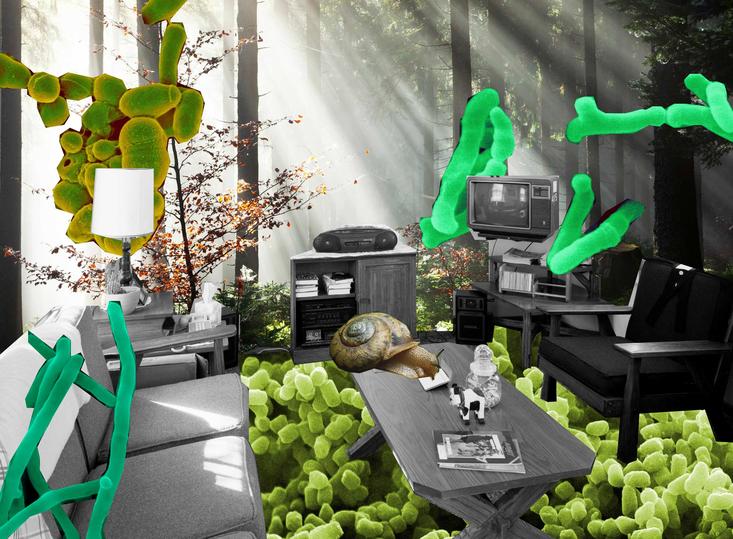COVID-19 has forced us all to think about new ways to avoid germs in the workspace, public places and even in the privacy of our own homes. Fortunately, interior designers and manufacturers are responding to the demand and offering homeowners solutions to reduce the spread of germs and other harmful particles.
Here, industry professionals share some of the more helpful ideas and innovations currently available.
Easy-to-clean and sealed surfaces
In a survey of designers conducted by the National Kitchen + Bath Association, a trade group, a majority of respondents said that easy-to-clean surfaces would be an influential trend in the wake of the pandemic. "People want something that's easy to sanitize, such as stainless steel faces on dishwashers and refrigerators," says Peter Salerno, a certified master kitchen and bath designer and owner of Peter Salerno, Inc. in Wyckoff. "(Decorators) often put panels on them, but non-porous surfaces are easier to clean because they don't have crevices."
Salerno also praises non-porous countertops such as quartz, which, unlike marble, limestone and granite, doesn't have small fissures, veining or indentations. A combination of pulverized stone and resin, "Quartz is poured in a mold, and doesn't have nature's flaws," he says. "It cleans like glass."
To keep bacteria such as E. coli and MRSA and mold from getting into cushions, homeowners can upholster their furniture with germ-resistant fabric such as Crypton, which incorporates, according to the company's website, EPA-approved silver-ion antimicrobial protection (it also repels stains).
In the bathroom, plumbing products manufacturer Kohler makes a factory-installed surface treatment called CleanCoat that, when applied to shower doors and toilets, prevents bacteria, mildew and mineral deposits from sticking to them.

Touchless technology
Smart home technology — voice and motion-activated appliances and other features — has grown tremendously in the recent past, and touchless options have expanded since COVID-19 to meet the demand. "Since May 1, the term 'touchless' has been the GROHE website's number one searched term," says Stephany Osmas, a spokesperson for the manufacturer of kitchen and bathroom fixtures.
With the kitchen often described as the heart of a home, maybe it's not surprising that according to The National Sanitation Foundation (NSF), areas where food is stored and prepared are sources of more bacteria than other places in the home — including the toilet, which homeowners are usually more conscious of cleaning.
To reduce the spread of germs in the kitchen, GROHE offers a touchless kitchen faucet that turns on and off with a tap of a foot control; after 60 seconds, the faucet automatically turns off. A hands-free faucet is another innovation; water flow may be controlled with a touch of the wrist, forearm or back of the hand. Plumbing fixture maker Kohler’s Sensate and Setra faucets allow users to turn water on and off either manually or by moving cookware or utensils — for example, by lifting a pot. These and other models also offer a voice-activated option using voice assistant devices already in the home.
Outlook:New models predict NJ COVID cases, hospitalizations outlook with vaccine rollout
Potential 'game-changer':Hopes high for Johnson & Johnson COVID vaccine if authorized
We did the math:Here's why it is so hard to get a COVID vaccine appointment in New Jersey
Touchless soap dispensers and faucets have been available to private and commercial buyers for some years. Now GROHE has created an electronic, sensor-activated faucet that features touchless on-and-off capability using batteries; it can accommodate 150 uses per day. And this March, “Kohler is launching a new line of touchless flush toilets designed with … (a) sensor built into the flush handle,” says Vicki Hafenstein, a company spokesperson.
Better air quality
Kitchen designer Peter Salerno sees air quality as being increasingly important to homeowners concerned about living in a healthy environment. The energy-efficiency movement, he argues, has made houses so air-tight with triple insulation and triple-hung windows that there’s a greater need for air-freshening. “My nephew is a health inspector in Bergen County, and he says the biggest problem is that air systems aren’t taking impurities out of the air," he says. "You could be recirculating bad air in your house.”
Salerno says he’s seen growing demand for make-up air systems — designed to “make up” the air in an interior space that has been removed due to process exhaust fans. A type of HVAC(heating, ventilation, and air conditioning) system, it pulls in fresh air from outside the home to replace air that can’t be recirculated; kitchen fans do this, he says, moving up to 800 cubic feet per minute outside to be replaced by air coming in through a damper.
Hepa (high efficiency particulate air) filters have also seen a boom in sales; in October, a Texas manufacturer told CNBC.com that since the pandemic, high-quality air filters have been flying off the shelves, proclaiming that “It’s like toilet paper in April, times two.” The American Society of Heating, Refrigerating and Air-Conditioning Engineers rates Hepa filters highly because they capture nearly 100% of microscopic air particles. “You can plug them into a wall and use them anywhere,” says Salerno.
